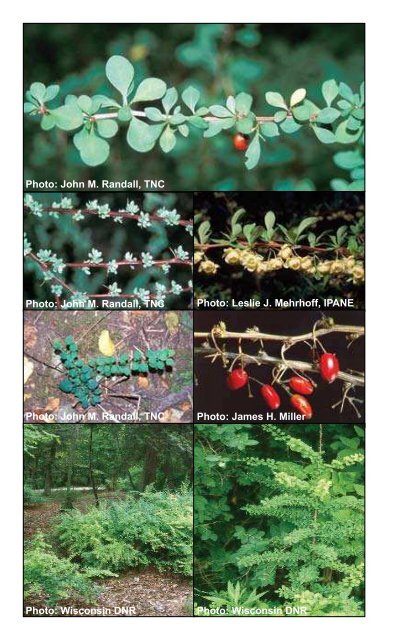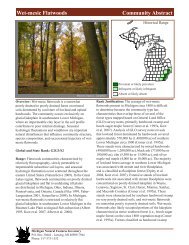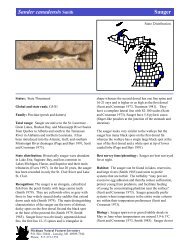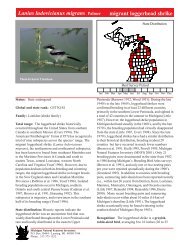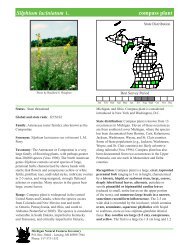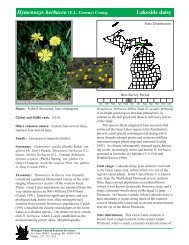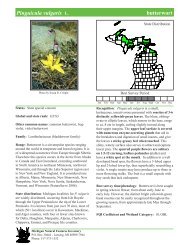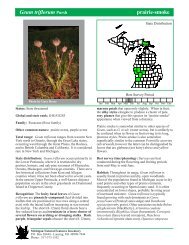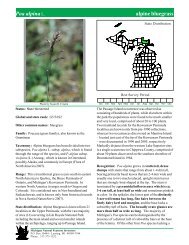Invasive Plants - Michigan Natural Features Inventory - Michigan ...
Invasive Plants - Michigan Natural Features Inventory - Michigan ...
Invasive Plants - Michigan Natural Features Inventory - Michigan ...
Create successful ePaper yourself
Turn your PDF publications into a flip-book with our unique Google optimized e-Paper software.
Japanese Barberry<br />
Berberis thunbergii<br />
Photo: John M. Randall, TNC<br />
Habit: Spiny, deciduous shrub, typically 0.5-1 m (2-3 ft) tall.<br />
Leaves: Simple, alternate, oval to spoon shaped with smooth<br />
margins, 1.3-2 cm (0.5-0.75 in) long; bright green above, lighter<br />
below, in clusters at each node, red to purple in the fall depending<br />
on the cultivar.<br />
Stems/bark: Numerous, spiny, slightly curving; older stems gray;<br />
twigs and young stems turning reddish brown in winter; inner bark<br />
yellow.<br />
Flowers: Small, yellow, stalked; single or in small<br />
clusters of 2-4 blossoms; bloom April-May.<br />
Fruits/seeds: Small, bright red, egg-shaped berries found singly<br />
or in clusters on slender stalks; mature in midsummer; remain<br />
on stems into winter; often dispersed by birds, deer, turkey and<br />
grouse. Some cultivars appear to produce little or no fruit.<br />
Habitat: Found along woodland edges, open woods, roadsides,<br />
Photo: John M. Randall, TNC Photo: Leslie J. Mehrhoff, IPANE<br />
stream banks, old fields; tolerates a range of soil, moisture and<br />
light conditions; can establish under forest canopy.<br />
Reproduction: By seed; creeping roots and cut stumps; branches<br />
root freely where they touch the ground.<br />
Similar species: American barberry (B. canadensis), which is not<br />
native to <strong>Michigan</strong>, has toothed leaves and usually three pronged<br />
spines.<br />
Photo: John M. Randall, TNC Photo: James H. Miller<br />
Comments: Native to Japan. Barberry is a common horticultural<br />
species and frequently escapes from cultivation; deer herbivory<br />
minimal. The non-native common barberry (B. vulgaris) is also<br />
invasive but was eradicated from large parts of its range, including<br />
<strong>Michigan</strong>, in the early twentieth century as it is a host to black<br />
stem grain rust.<br />
Monitoring & rapid response: Monitor sunny open sites and<br />
edges in spring when barberry leafs out before native shrubs. Begin<br />
control efforts in highest quality areas; hand pull or dig young<br />
plants, removing all roots. Target mature shrubs that provide a<br />
source of seed; cutting effective when cut stumps are treated with<br />
herbicide; foliar herbicide treatment is effective in areas with few<br />
native plants. In fire-adapted communities, late spring burns with<br />
30 Photo: Wisconsin DNR Photo: Wisconsin DNR<br />
good fuel may kill seedlings.<br />
31


